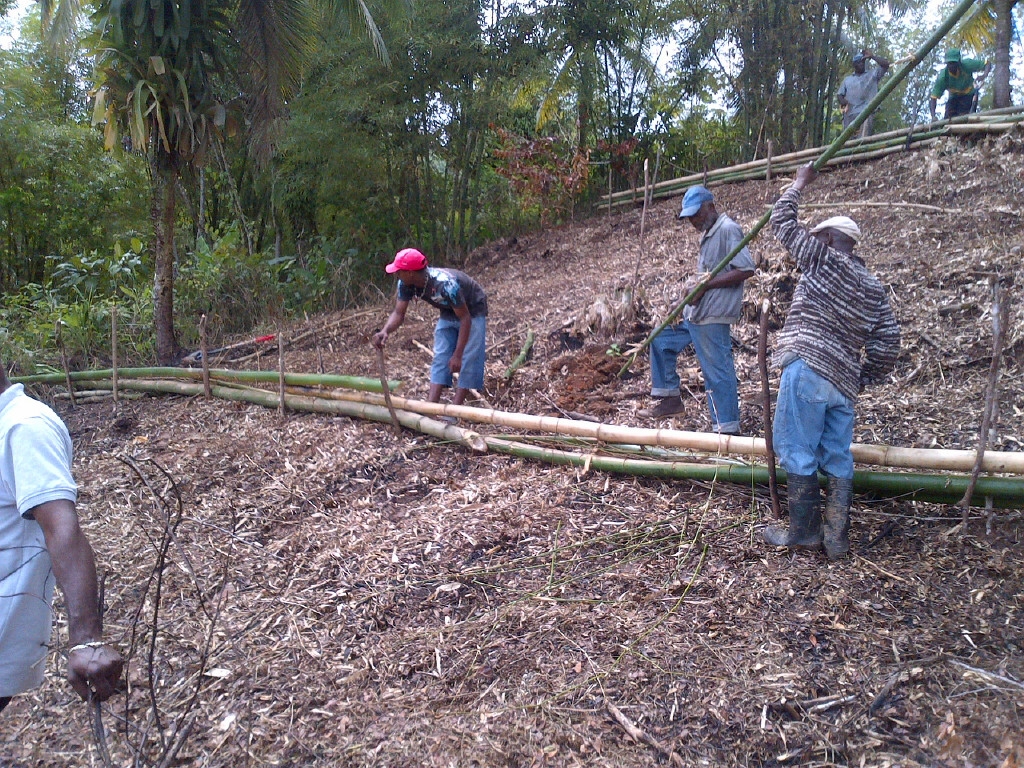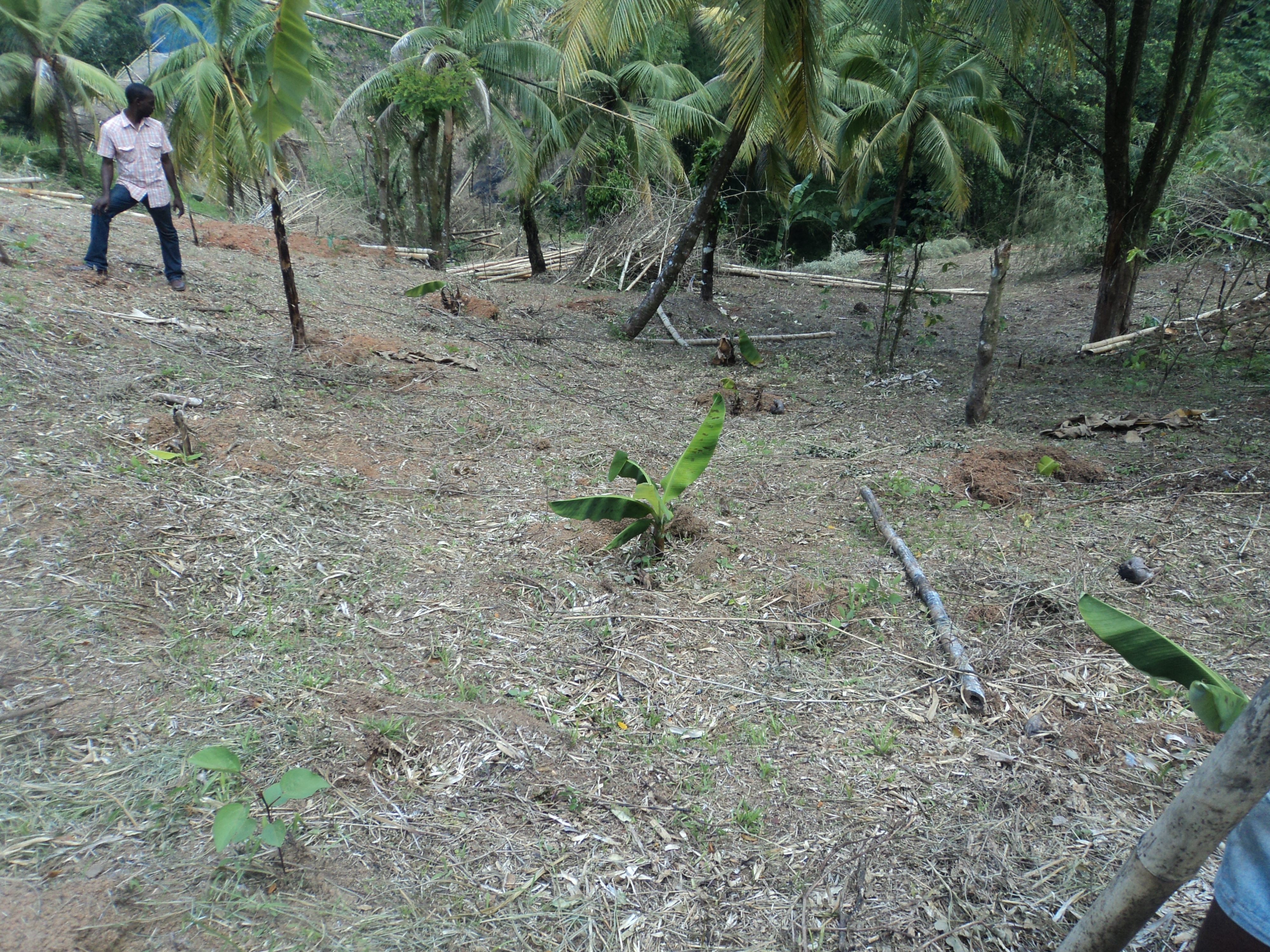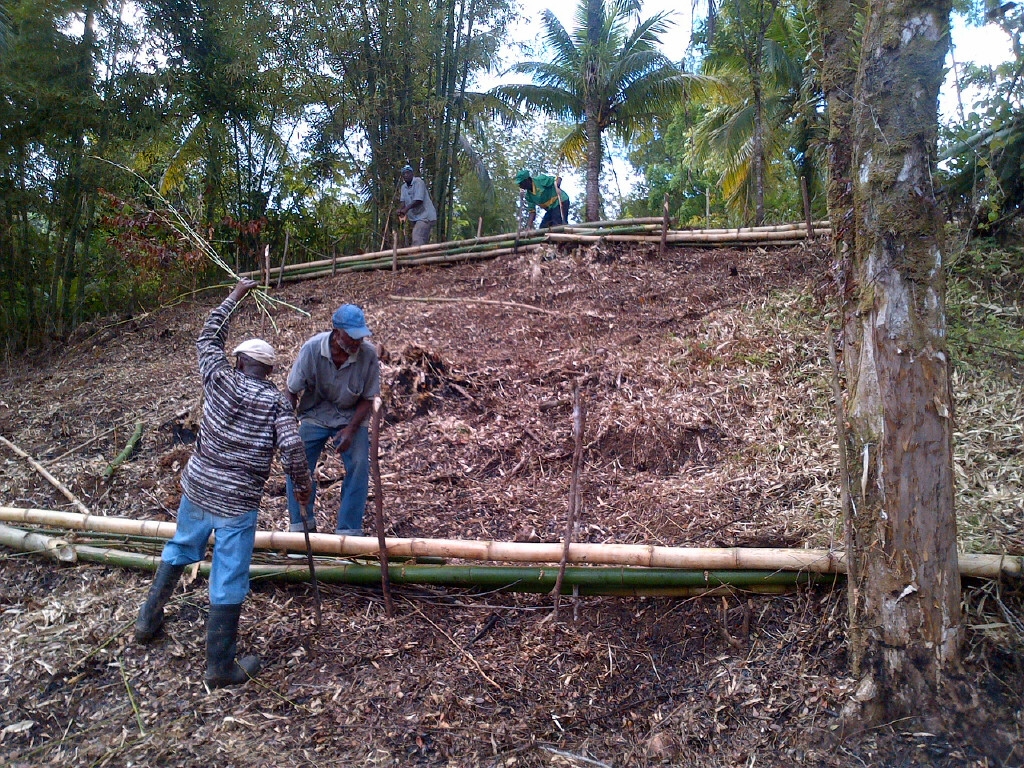CBA Jamaica: Watershed Conservation Programme for Awareness and Action in the Rio Grande Watershed
Project Overview
Approximately 2,000 people reside in Bellevue, Cornwall Barracks, and Moore Town, and another 23,000 residents live in the surrounding Rio Grande Watershed area of Jamaica. Local residents mainly consist of self- employed farmers, traders, carvers and rafters. These communities experience tropical storms and hurricanes during Jamaica’s rainy season (October-February), and the communities are hardest hit in June through November. The climate change-induced heavy rainfall leads to erosion and landslides, which impacts local farming, the main source of income for the communities.
This Community-Based Adaptation project seeks to educate and inform community stakeholders about the functions and values of a watershed, the values of the watershed to the community, and the specific actions community members can take to protect the watershed and ensure the continued provision of essential ecosystem services. It is multi-faceted, featuring a comprehensive education program and practical land management measures required to reduce environmental degradation in the watershed.
* This project is part of Jamaica's Community-Based Adaptation portfolio. *
Project Details
The communities of Bellevue, Moore Town and Cornwall Barracks, Jamaica, are home to about 2,000 people. A significant percentage of the population consists of self-employed farmers, followed in number by traders, carvers and rafters. The farmers’ livelihoods depend upon a form of hillside farming that both contributes significantly to erosion and is greatly threatened by it. The traders (higglers) are mostly female, and deal mostly in cash crops acquired from the small farmers—making them equally as vulnerable.
The local ecosystem is naturally lush and forested, and prone to heavy annual rainfall. Because storms and prevailing winds generally approach from the east, the Portland region is exceptionally vulnerable to devastation by tropical storms or hurricanes. The Rio Grande Watershed is particularly susceptible to flooding and landslides as a result of its topography and fast flowing rivers. Due to population growth and increased hillside farming, more and more trees have been removed, and wind and water have increased soil erosion rates.
Land degradation and biodiversity are both threatened by poor farming practices and deforestation. The poor practices such as the methods used to prepare land for planting result in the unnecessary removal of native vegetation and the exposure of land to the elements. This has resulted in the loss of native flora and the related loss of native fauna as result of habitat loss. It has also resulted in a loss of soil fertility, the erosion of soil and reduced water quality within the Rio Grande watershed.
This Community-Based Adaptation project will benefit the communities within the watershed by allowing them to farm sustainably, reducing erosion and landslides while increasing water quality. Reforestation projects, crop diversification pilots, and farming best practices workshops/demonstrations will all be carried out with farmers and community members. The incorporation of cover crops and conservation tillage will serve to not only mitigate against climate change impacts but also to reduce the vulnerability of farms in the target area to the risks associated with climate change. An education program will allow the community to become more knowledgeable about its surrounding environment, how climate change is affecting it, and how to prevent damage. Because this is a watershed enhancement project, anyone who uses the roads, water, or depends on agricultural goods produced in this area will benefit.
Key Results and Outputs
Outcome 1: Reduced Erosion and Landslides
Stabilize soil through seedling distribution and tree planting (Output 1.1). Encourage improved farming techniques through presentations and workshops (Output 1.2), as well as soil conservation demonstration plots (Output 1.3).
Outcome 2: Reduced Carbon Emissions
Plant 5,000 native and timber tree seedlings (Output 2.1) in conjunction with climate change awareness presentations to schools and community groups (Output 2.2).
Outcome 3: Increased Water Conservation and Quality
Soil stability projects lead to decreased erosion, reduced siltation, and a resultant improvement in water quality (Output 3.1). Re-educate farmers on appropriate fertilizer usage (Output 3.2) and water harvesting techniques (Output 3.3) to reduce runoff and conserve water.
Reports and Publications
News article
CBA Jamaica - Poster Competition - Press Release (Feb. 2012)
PIFs
Project Brief / Fact Sheet
Monitoring and Evaluation
Monitoring and evaluation for community-based adaptation is a new field, and the CBA project is piloting innovative approaches to evaluating the success of locally-driven adaptation projects, and generating lessons to inform ongoing practice.
Key considerations in M&E for CBA include:
- Grounding M&E in the local context: M&E for CBA should avoid overly rigid frameworks, recognizing community heterogeneity and maintaining local relevance
- Capturing global lessons from local projects: CBA projects are highly contextualized, but lessons generated should be relevant to stakeholders globally
- Incorporation of both quantitative and qualitative indicators: to ground projects in tangible changes that can be objectively evaluated, and to capture lessons and case studies for global dissemination
To these ends, the CBA project uses three indicator systems: the Vulnerability Reduction Assessment, the Small Grants Programme Impact Assessment System, and the UNDP Climate Change Adaptation Indicator Framework.
The Vulnerability Reduction Assessment (VRA)
The VRA is a question-based approach with the following aims:
- To make M&E responsive to community priorities
- To use M&E to make projects more accountable to local priorities
- To make M&E capture community ideas and local knowledge
- To gather community-level feedback to guide ongoing project management
- To generate qualitative information
- To capture lessons on specific issues within community-based adaptation
- To generate case studies highlighting adaptation projects
The VRA follows UNDP's Adaptation Policy Framework, and is measured in a series of meetings with local community stakeholders. In these meetings, locally-tailored questions based on standard VRA questions/indicators are posed, and the community assigns a numerical score on a 1-10 scale for each question. Progress is evaluated through changes in scores over the course of implementation, as well as through qualitative data collected in community discussions surrounding the exercise.
UNDP has developed a Users Guide to the VRA (Espanol) (Francais) as a tool to assist practitioners to conceptualize and execute VRA measurements in the context of CBA projects.
The SGP Impact Assessment System (IAS)
The CBA, being a project of the GEF Strategic Priority on Adaptation, aims to increase the resilience of ecosystems and communities to the impacts of climate change, generating global environmental benefits, and increasing their resilience in the face of climate change impacts. To this end, the CBA projects use the SGP's impact assessment system for monitoring achievements in GEF focal areas (focusing primarily on biodiversity and sustainable land management).
The IAS is composed of a number of quantitative indicators which track biophysical ecosystem indicators, as well as policy impact, capacity development and awareness-building.
UNDP Climate Change Adaptation Indicator Framework
CBA projects also track quantitative indicators from UNDP's adaptation indicator framework, corresponding to the thematic area on natural resources management. More information on UNDP's indicator framework can be found on the UNDP climate change adaptation monitoring and evaluation website.
* This description applies to all projects implemented through UNDP's Community-Based Adaptation programme. Specific details on this project's M&E will be included here as they become available. *







